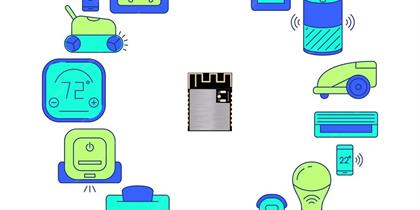
Enriching the Museum Experience: The Role of Bluetooth Beacons
October 09, 2024
![]() In the hallowed halls of museums, history comes alive through artifacts and exhibits that tell stories of the past. However, the experience can be enhanced by integrating modern technology with traditional curatorship. Bluetooth Beacons have emerged as a key tool in this fusion, offering a new dimension to the way visitors interact with museums. These small, unobtrusive devices use low-energy Bluetooth signals to communicate with smartphones and other devices, creating a personalized and immersive experience for visitors.
In the hallowed halls of museums, history comes alive through artifacts and exhibits that tell stories of the past. However, the experience can be enhanced by integrating modern technology with traditional curatorship. Bluetooth Beacons have emerged as a key tool in this fusion, offering a new dimension to the way visitors interact with museums. These small, unobtrusive devices use low-energy Bluetooth signals to communicate with smartphones and other devices, creating a personalized and immersive experience for visitors.
The Beacon’s Role in Museums
Bluetooth Beacons are wireless transmitters that can detect the presence of mobile devices within their vicinity. In a museum setting, beacons can be placed at various exhibits to provide a wealth of information and interactive content to visitors. As a visitor approaches an exhibit, their device can receive a signal from the beacon, triggering an app to display relevant information, images, or videos that enrich the understanding and appreciation of the exhibit.
Enhancing Visitor Engagement
One of the primary benefits of using Bluetooth Beacons in museums is the ability to engage visitors on a more personal level. By pushing tailored content to visitors’ devices, museums can provide a narrative that is both informative and entertaining. For instance, as a visitor stands before a painting, the beacon can trigger an app to display the artist’s biography, the historical context of the artwork, or even a virtual walkthrough of the period in which it was created.
Educational Opportunities
Bluetooth Beacons also offer significant educational potential. They can be used to guide students through a museum, providing interactive lessons that align with curriculums. For example, a history class visiting an art museum can receive information tailored to their study topics, making the visit a living classroom that brings textbooks to life.
Navigation and Wayfinding
Museums can be labyrinthine, with vast collections spread across numerous rooms and floors. Beacons can assist visitors by providing navigation assistance, guiding them to specific exhibits or directing them to amenities such as restrooms, cafes, or gift shops. This can enhance the visitor’s experience by reducing frustration and ensuring they make the most of their time in the museum.
Data Collection and Analysis
As beacons interact with visitors’ devices, they can collect valuable data on visitor behavior and preferences. This data can be analyzed to understand which exhibits are most popular, how long visitors spend at each exhibit, and even the pathways they take through the museum. Armed with this information, curators can make informed decisions about exhibit placement, event planning, and marketing strategies.
Challenges and Considerations
Despite their potential, there are challenges associated with implementing Bluetooth Beacons in museums. Privacy concerns are paramount, as visitors may be wary of technology that tracks their movements. Museums must ensure that the use of beacons is transparent and that visitors can opt-out if they wish. Additionally, the initial cost of deploying beacons and the ongoing maintenance of the technology can be significant.
The Future of Bluetooth Beacons in Museums
As technology advances, the capabilities of Bluetooth Beacons are expected to expand. Future beacons may offer more advanced data analytics, integration with artificial intelligence for personalized recommendations, and even augmented reality experiences that bring exhibits to life in extraordinary ways.
Conclusion
Bluetooth Beacons are redefining the museum experience, offering a conduit for personalized engagement and interactive learning. As museums continue to seek ways to enhance visitor experiences and operational efficiency, the role of Bluetooth Beacons is set to become even more pivotal. As the technology matures, we can expect to see even more innovative applications of beacons in the museum environment, ensuring that the museum of the future is as technologically advanced as it is historically rich.
You Might Like Also

In the quest for cleaner and healthier indoor air, Bluetooth modules have become an integral part of modern air purifiers. These compact devices enable wireless communication between the air purifier and other systems, such as smartphones or home automation networks. By integrating Bluetooth technology, air purifiers can offer a range of advanced f Read More

In the modern landscape of wireless technology, Bluetooth modules have become indispensable components, enabling a myriad of applications that enhance our daily lives. These compact devices, embedded within a wide array of products, facilitate communication and connectivity with minimal effort. This article delves into the diverse applications of B Read More

The Versatility of Bluetooth Modules: Unleashing Connectivity
In the realm of wireless communication, Bluetooth modules have emerged as the Swiss Army knife of connectivity, enabling seamless interaction between devices over short distances. These compact devices have become indispensable in a variety of applications, from consumer electronics to industrial automation. Bluetooth modules are the silent workhor Read More

Bluetooth beacon used in Indoor Positioning Systems
Bluetooth beacons have become an essential component in Indoor Positioning Systems (IPS), providing accurate location data that enhances various applications within controlled environments. In smart retail settings, beacons play a crucial role in enhancing customer experiences, optimizing store operations, and driving business insights. Read More

The role of Bluetooth beacons in RTLS
Bluetooth beacons are playing an increasingly vital role in Real-Time Locating Systems (RTLS), particularly within the context of warehouse management. These tiny, yet powerful devices, are redefining the way warehouses operate, offering a new level of efficiency and precision that is transforming inventory tracking and asset management. Read More

Bluetooth Beacon: The game-changer of Smart Parking
Bluetooth beacons can also play a role in enhancing safety and security within warehouse parking areas. They can be used to monitor pedestrian traffic and alert drivers to potential hazards, ensuring that the parking area remains a safe environment. Additionally, beacons can be programmed to restrict access to certain areas, adding an extra layer o Read More











